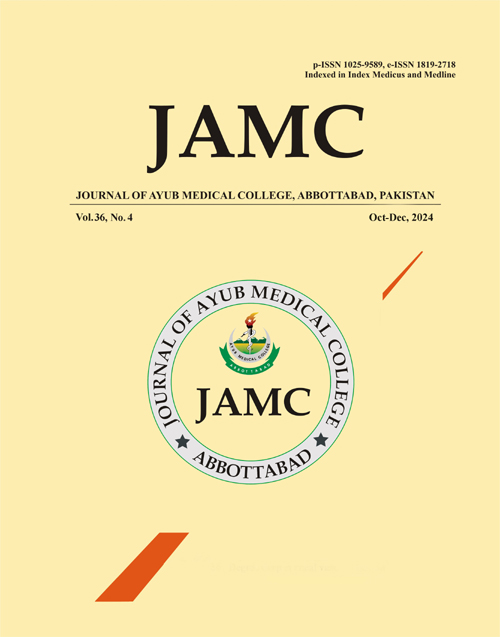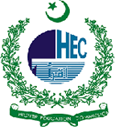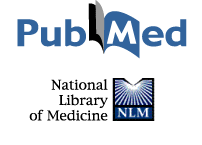COMPARISON OF EFFICACY AND SAFETY OF RANOLAZINE AND IVABRADINE IN CHRONIC ISCHEMIC HEART DISEASE PATIENTS
Keywords:
Efficacy, Ivabradine, Ischemic heart disease, Ranolazine, side effectsAbstract
Background: Ischemic heart disease (IHD) frequently produces persistent angina that may significantly impair quality of life despite standard treatment. There is need for effective adjunctive therapies to manage refractory angina. Ranolazine and Ivabradine are two potential options that have shown efficacy in alleviating angina symptoms and improving quality of life in IHD patients. Methods: Ethical clearance was obtained from hospital ethical committee before initiation of study. Those patients fulfilling study inclusion criteria were enrolled. Written informed consent was obtained from all the patients. This randomized clinical trial enrolled patients from the Department of Cardiology, PIMS Hospital, Islamabad. The information regarding demographic and baseline patient characteristics were recorded. Patients were randomly assigned into two groups by lottery method. Treatment group (group A) was Ranolazine 500 mg tablets twice daily for 8 weeks plus standard treatment while the Placebo group (group B) was Ivabradine 5 mg tablets twice daily for 8 weeks plus standard treatment. The primary outcome of study was improvement in angina as assessed by SAQ. Other outcomes like hemodynamic stability (heart rate and Blood pressure) and associated side effects were also recorded at 2, 4, 6, and 8 weeks after the start of treatment in both the study groups. The collected data was analyzed by using SPSS 23 version. Results: The mean age of patients in Group A was 64.59±5.47 years and in Group B were 65.41±5.95 years. In Group A 36(78.3%) patients were male and 10(21.7%) patients were female and in Group B 38(82.6%) patients were male and 8(17.4%) patients were female. The baseline score of SAQ in Group A and Group B was as (41.93±4.23 vs 43.24±4.44) and at 8 week as (90.98±3.12 vs 81.48±2.52). Ranolazine had better clinical outcome than Ivabradine for the treatment of persistent angina in patients with chronic stable ischemic heart disease in terms of SAQ score, systolic & diastolic blood pressure and safety profile. Conclusion: This study concluded that Ranolazine in comparison to Ivabradine has better clinical outcomes in terms of efficacy & safety in patients with chronic IHD who had persistent symptoms.
References
Kyavar M, Alemzadeh-Ansari MJ. Stable ischemic heart disease. Practical cardiology: Elsevier; 2022. p. 429-53. https://doi.org/10.1016/B978-0-323-80915-3.00026-0
Ferraro R, Latina JM, Alfaddagh A, Michos ED, Blaha MJ, Jones SR, et al. Evaluation and management of patients with stable angina: beyond the ischemia paradigm: JACC state-of-the-art review. Journal of the American College of Cardiology. 2020;76(19):2252-66. https://doi/abs/10.1016/j.jacc.2020.08.078
Costa LL, Islam MS, Anowar MN, Latif MA. Quality of life of chronic heart failure patients. Open Journal of Nursing. 2020;10(9):831-57. DOI: 10.4236/ojn.2020.109058
McChord J, Hubert A, Bekeredjian R, Ong P. Contemporary pharmacological treatment strategies for patients with angina and unobstructed coronary arteries (ANOCA) due to coronary microvascular dysfunction. Vessel Plus. 2021;5(49):2574-1209.2021. DOI: 10.20517/2574-1209.2021.63
Davies A, Fox K, Galassi AR, Banai S, Ylä-Herttuala S, Luescher TF. Management of refractory angina: an update. European Heart Journal. 2021;42(3):269-83. https://doi.org/10.1093/eurheartj/ehaa820
BODEN WE. Drugs for Ischemic Heart. Opie's Cardiovascular Drugs: A Companion to Braunwald's Heart Disease E-Book. 2020:1.
Khan MA, Hashim MJ, Mustafa H, Baniyas MY, Al Suwaidi SKBM, AlKatheeri R, et al. Global epidemiology of ischemic heart disease: results from the global burden of disease study. Cureus. 2020;12(7). doi: 10.7759/cureus.9349
Ullah SA, Shah ST, Khan S, Khalil AA. Frequency and Pattern of Coronary Artery Disease and Its Associated Risk Factors in Stable Ischemic Heart Disease Patients Undergoing Coronary Angiography: A Cross Sectional Study. J Khyber Coll Dent. 2020;10:1-6.
Le DE, Davis CM, Wei K, Zhao Y, Cao Z, Nugent M, et al. Ranolazine may exert its beneficial effects by increasing myocardial adenosine levels. American Journal of Physiology-Heart and Circulatory Physiology. 2020;318(1):H189-H202. https://doi.org/10.1152/ajpheart.00217.2019
Tahir F, Arif TB, Majid Z, Ahmed J, Khalid M. Ivabradine in postural orthostatic tachycardia syndrome: a review of the literature. Cureus. 2020;12(4).
Nedoshivin A, Petrova PT, Karpov Y. Efficacy and safety of Ivabradine in combination with beta-blockers in patients with stable angina pectoris: A systematic review and meta-analysis. Advances in Therapy. 2022;39(9):4189-204.
Manolis A, Boden W, Collins P, Dechend R, Kallistratos M, Sendon JL, et al. State of the art approach to managing angina and ischemia: tailoring treatment to the evidence. European Journal of Internal Medicine. 2021;92:40-7. https://doi.org/10.1016/j.ejim.2021.08.003
Kofler T, Hess S, Moccetti F, Pepine CJ, Attinger A, Wolfrum M, et al. Efficacy of ranolazine for treatment of coronary microvascular dysfunction-a systematic review and meta-analysis of randomized trials. CJC open. 2021;3(1):101-8. https://doi.org/10.1016/j.cjco.2020.09.005
Chaturvedi A, Singh Y, Chaturvedi H, Thawani V, Singla S, Parihar D. Comparison of the efficacy and tolerability of ivabradine and ranolazine in patients of chronic stable angina pectoris. Journal of Pharmacology and Pharmacotherapeutics. 2013;4(1):33-8. https://doi.org/10.4103/0976-500X.107663
Saha S, Ete T, Kapoor M, Jha PK, Megeji RD, Kavi G, et al. Effect of ranolazine in patients with chest pain and normal coronaries-a hospital based study. Journal of Clinical and Diagnostic Research: JCDR. 2017;11(4):OC14. https://doi.org/10.7860%2FJCDR%2F2017%2F24405.9617
Padala SK, Lavelle MP, Sidhu MS, Cabral KP, Morrone D, Boden WE, et al. Antianginal therapy for stable ischemic heart disease: a contemporary review. Journal of Cardiovascular Pharmacology and Therapeutics. 2017;22(6):499-510. https://doi.org/10.1177/1074248417698224
Kalvelage C, Stoppe C, Marx N, Marx G, Benstoem C. Ivabradine for the therapy of chronic stable angina pectoris: a systematic review and meta-analysis. Korean Circulation Journal. 2020;50(9):773-86. https://doi.org/10.4070/kcj.2020.0031
Borer JS, Fox K, Jaillon P, Lerebours G. Clinical Investigation and Reports-Antianginal and Antiischemic Effects of Ivabradine, an If Inhibitor, in Stable Angina: A Randomized, Double-Blind, Multicentered, Placebo-Controlled Trial. Circulation-Hagertown. 2003;107(6):817-23. https://doi.org/10.1161/01.CIR.0000048143.25023.87
Belardinellia L, Antzelevitch C, Fraserc H. Inhibition of late (sustained/persistent) sodium current: a potential drug target to reduce intracellular sodium-dependent calcium overload and its detrimental effects on cardiomyocyte function. Eur Heart J Suppl. 2004;6(suppl_I):i3-i7. https://doi.org/10.1093/eurheartj/6.suppl_i.i3
Chaturvedi A, Singh Y, Chaturvedi H, Thawani V, Singla S, Parihar D. Comparison of the efficacy and tolerability of ivabradine and ranolazine in patients of chronic stable angina pectoris. J Pharmacol Pharmacother. 2013;4(1):33. https://doi.org/10.4103/0976-500X.107663
Jönsson R, Sixt E, Landahl S, Rosenhall U. Prevalence of dizziness and vertigo in an urban elderly population. Journal of vestibular research. 2004;14(1):47-52. https://doi.org/10.4103/0976-500X.107663
Chaitman BR, Skettino SL, Parker JO, Hanley P, Meluzin J, Kuch J, et al. Anti-ischemic effects and long-term survival during ranolazine monotherapy in patients with chronic severe angina. J Am Coll Cardiol. 2004;43(8):1375-82. doi/full/10.1016/j.jacc.2003.11.045
Stone PH, Chaitman B, Koren A, Crager M. Effects of ranolazine as monotherapy and combination therapy on rate pressure product at rest and during exercise: results from the MARISA and CARISA trials. Am Heart Assoc; 2006. doi/abs/10.1161/circ.114.suppl_18.II_714-c
Rognoni A, Barbieri L, Cavallino C, Bacchini S, Veia A, Degiovanni A, et al. Ranolazine: Effects on ischemic heart. Recent Patents on Cardiovascular Drug Discovery (Discontinued). 2013;8(3):197-203.
Vadnais DS, Wenger NK. Emerging clinical role of ranolazine in the management of angina. Therapeutics and clinical risk management. 2010;6:517. doi/full/10.2147/TCRM.S4468
Ndegwa S. Ranolazine (Ranexa) for chronic stable angina. Issues in Emerging Health Technologies. 2007(99):1-6.
Tamargo J, Lopez-Sendon J. Ranolazine: a better understanding of pathophysiology and patient profile to guide treatment of chronic stable angina. Future Cardiology. 2021(0). https://doi.org/10.2217/fca-2021-0058
Published
How to Cite
Issue
Section
License
Copyright (c) 2024 Ahsan Waqas Khan Niazi, Ahsan Nisar, Syed Naveed Pirzada, Naveed Yaqoob, Muhammad Naeem, Hafsa Shahid Malik, Muhammad Faisal Bacha

This work is licensed under a Creative Commons Attribution-NoDerivatives 4.0 International License.
Journal of Ayub Medical College, Abbottabad is an OPEN ACCESS JOURNAL which means that all content is FREELY available without charge to all users whether registered with the journal or not. The work published by J Ayub Med Coll Abbottabad is licensed and distributed under the creative commons License CC BY ND Attribution-NoDerivs. Material printed in this journal is OPEN to access, and are FREE for use in academic and research work with proper citation. J Ayub Med Coll Abbottabad accepts only original material for publication with the understanding that except for abstracts, no part of the data has been published or will be submitted for publication elsewhere before appearing in J Ayub Med Coll Abbottabad. The Editorial Board of J Ayub Med Coll Abbottabad makes every effort to ensure the accuracy and authenticity of material printed in J Ayub Med Coll Abbottabad. However, conclusions and statements expressed are views of the authors and do not reflect the opinion/policy of J Ayub Med Coll Abbottabad or the Editorial Board.
USERS are allowed to read, download, copy, distribute, print, search, or link to the full texts of the articles, or use them for any other lawful purpose, without asking prior permission from the publisher or the author. This is in accordance with the BOAI definition of open access.
AUTHORS retain the rights of free downloading/unlimited e-print of full text and sharing/disseminating the article without any restriction, by any means including twitter, scholarly collaboration networks such as ResearchGate, Academia.eu, and social media sites such as Twitter, LinkedIn, Google Scholar and any other professional or academic networking site.









